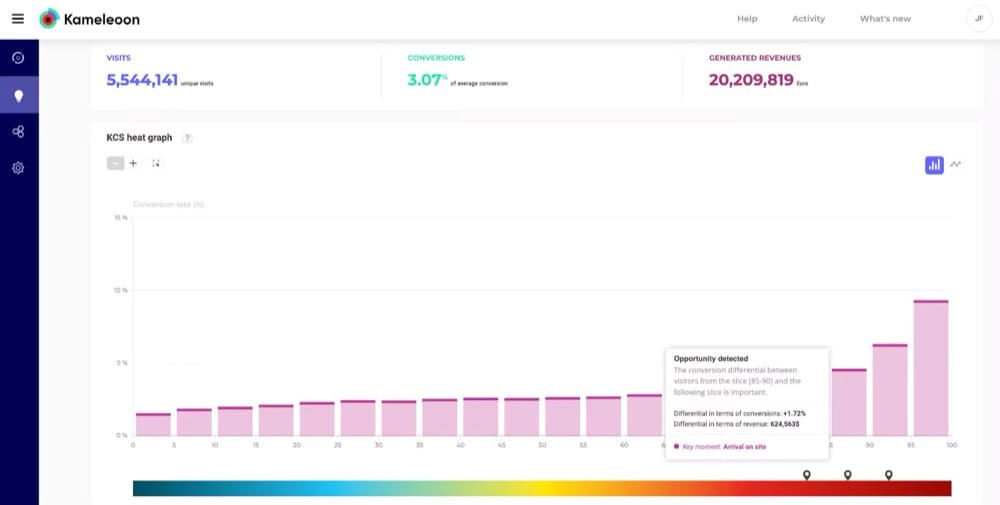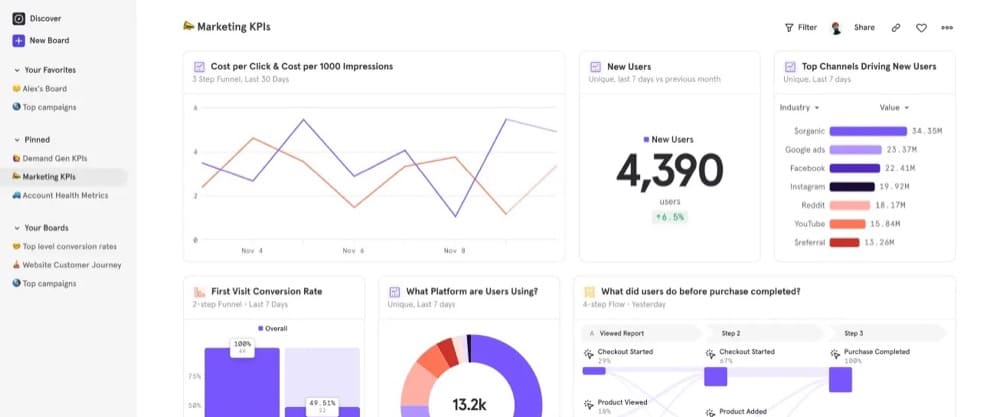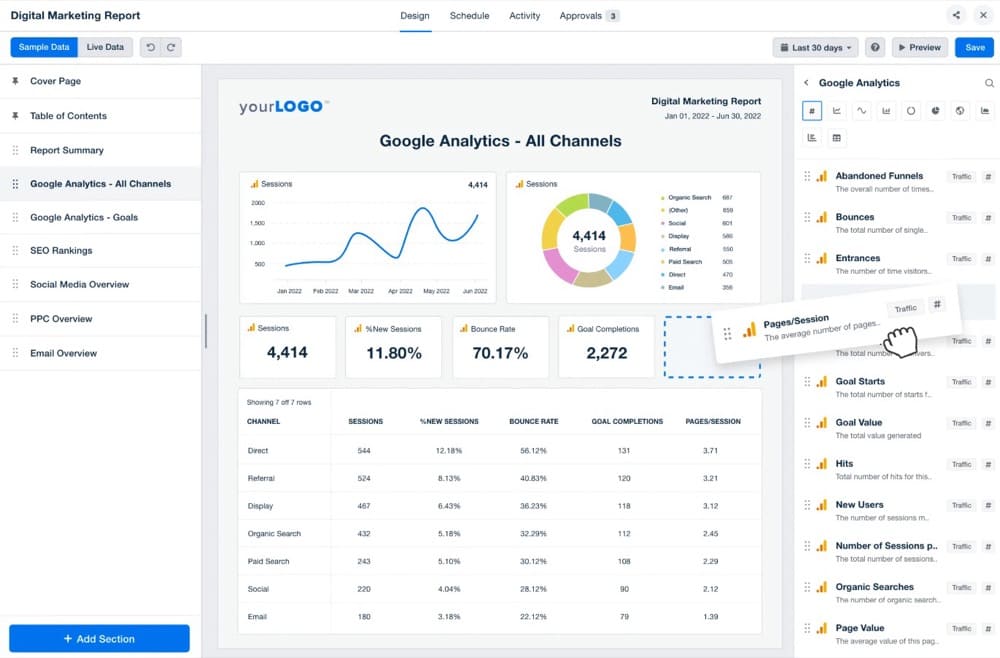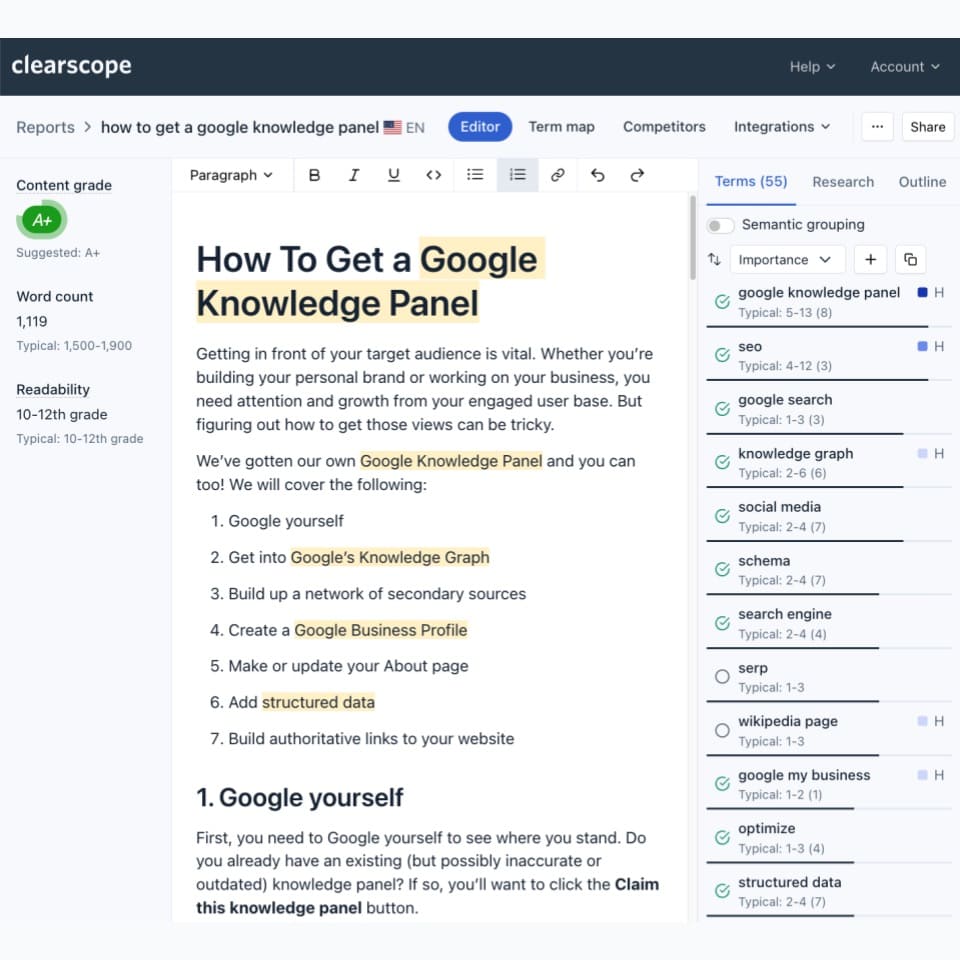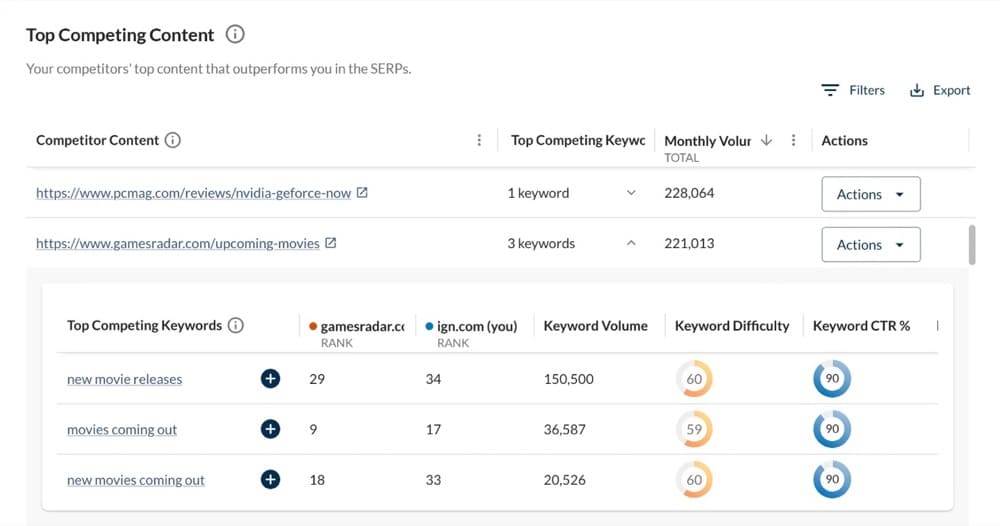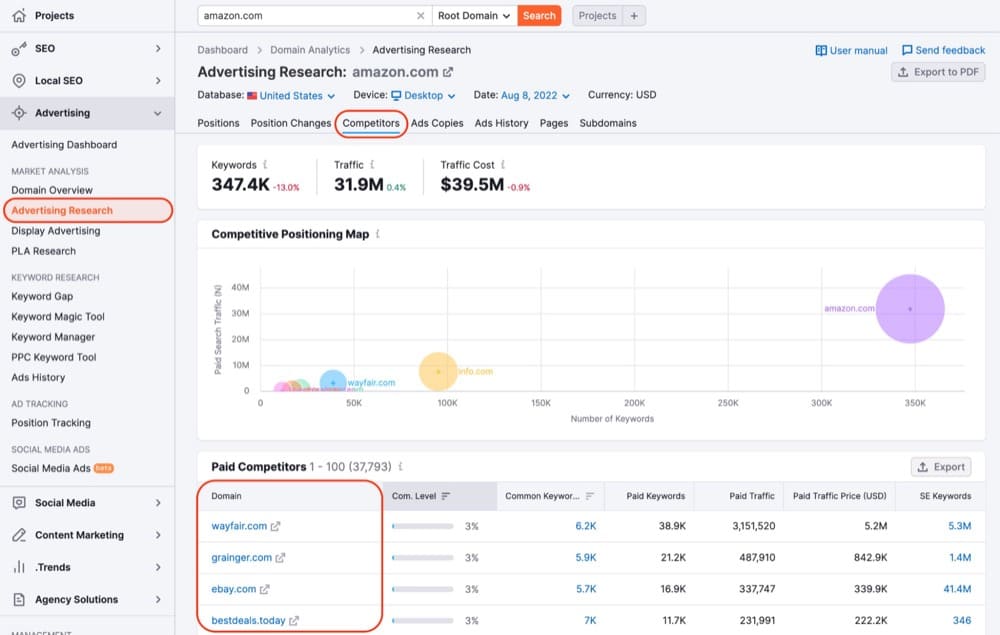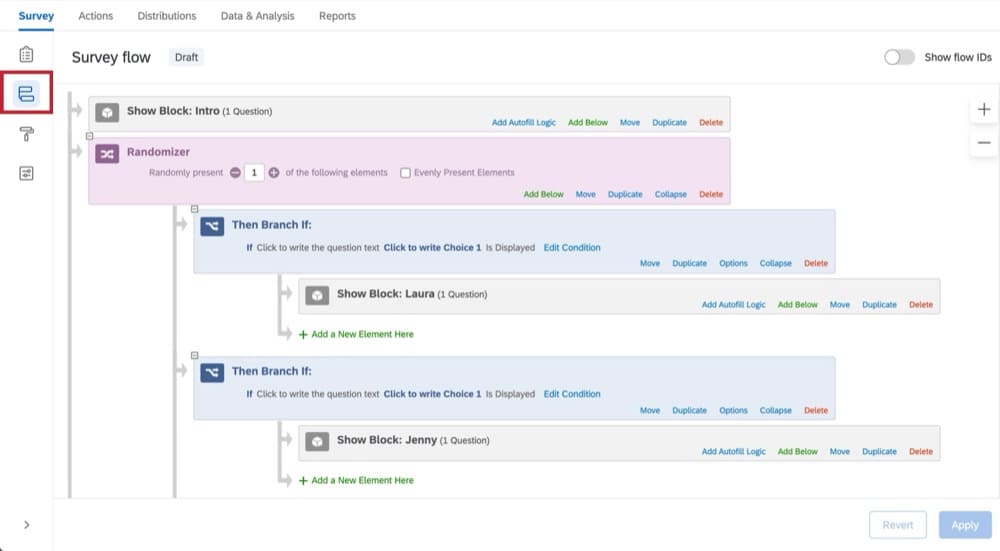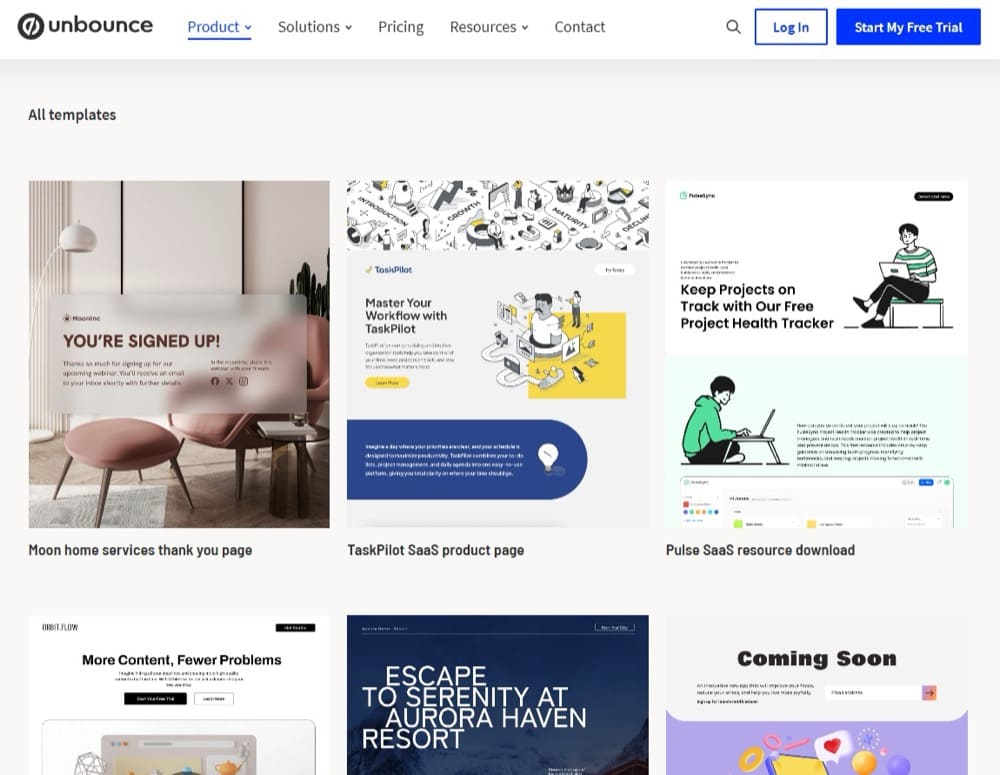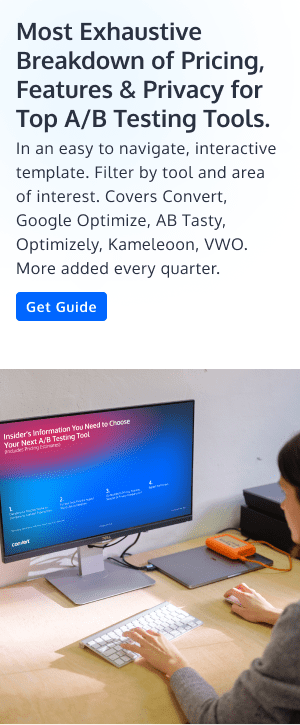28 Must-Have CRO Tools for Efficient Testing Workflows
Conversion rate optimization—the process of systematically improving business decisions and performance on a website or product—is now a mainstream and nearly ubiquitous discipline.
Instead of merely driving traffic through channels like organic search, paid ads, or social, the smartest marketers are analyzing user behavior and optimizing post-click experiences to drive efficient customer acquisition programs.
Still, this discipline is made up of several components, including user research, digital analytics, psychology, experimentation, copy, design, and project management. Thus, the landscape of CRO tools that help you accomplish better business results is expansive and sometimes confusing.
In this comprehensive guide, we’ll review the best CRO tools available in 2025, tailored specifically for in-house optimization teams and digital agencies. From A/B testing and heatmapping to website analytics and personalization, we’ll cover the essential tools you need to accelerate your testing process, uncover actionable insights faster, and create data-driven strategies that boost conversions.
Best CRO Tools for Agencies Comparison Chart
| Product | Starting Price | Free Trial? |
Key Features | Best For | |||||||||||||||||||||||||
|---|---|---|---|---|---|---|---|---|---|---|---|---|---|---|---|---|---|---|---|---|---|---|---|---|---|---|---|---|---|
| Convert | $299/month | Yes, 15 days | Advanced audience targeting, full stack experimentation, flicker-free testing technology, extensive integration ecosystem |
Transitioning from basic to advanced A/B testing | |||||||||||||||||||||||||
| AB Tasty | Contact sales | No | Visual editor, product and content recommendation engines, AI-powered segmentation |
Optimizing product discovery and recommendations |
|||||||||||||||||||||||||
| Kameleoon | Contact sales | Yes—Feature Experimentation suite only | Hybrid experimentation platform, intuitive visual editor, real-time segmentation engine |
High-velocity testing programs |
|||||||||||||||||||||||||
| Optimizely | Contact sales | No | Drag-and-drop visual editor, multi-armed bandit and multivariate testing, advanced targeting and segmentation |
Scaling experiments across multiple brands, products, and experiences |
|||||||||||||||||||||||||
| VWO | $393/month | Yes, 30 days | A/B and multivariate testing, visual editor, integrated behavior analytics tools |
Optimizing high-traffic e-commerce sites |
|||||||||||||||||||||||||
| Hotjar | $32/month | No, but offers a free plan | Heatmaps, session recordings, conversion funnels, continuous feedback collection |
Qualitative and quantitative user behavior insights |
|||||||||||||||||||||||||
| Contentsquare | $40/month | No, but offers a free plan | Visual journey analytics, ai-powered session replay, behavioral heatmaps |
Enterprise UX researchers |
|||||||||||||||||||||||||
| Mouseflow | $31/month | No, but offers a free plan | Session recording with segmentation, heatmap analytics, conversion funnel analysis, Friction Score |
Accelerating time to insights during data analysis |
|||||||||||||||||||||||||
| Smartlook | $55/month | Yes, 30 days and offers a free plan | Always-on session recordings, event-based conversion funnels, funnel-to-recording connection, cross-platform analytics |
Identifying root causes for checkout abandonment |
|||||||||||||||||||||||||
| Amplitude | $49/month | No, but offers a free plan | Integrated analytics dashboard, automated experiment tracking, cross-platform identity resolution, behavior targeting options |
Mapping multi-step funnel experiments to revenue outcomes |
|||||||||||||||||||||||||
| Mixpanel | $24/month | No, but offers a free plan | Advanced funnel analysis, real-time experimentation reports, cohort analysis and segmentation, custom event tracking |
Connecting revenue to acquisition and product management efforts |
|||||||||||||||||||||||||
| Google Search Console | Free | N/A | Performance analytics dashboard, query performance analysis, Core Web Vitals monitoring |
Auditing, analyzing, and monitoring organic search performance |
|||||||||||||||||||||||||
| AgencyAnalytics | $59/month | Yes, 14 days | Automated cross-campaign analytics, custom metrics and KPI tracking, AI-powered performance insights |
Agencies automating client performance reports |
|||||||||||||||||||||||||
| Ahrefs | $108/month | No | Content gap analysis, traffic potential metrics, historical traffic data, content explorer tool |
An all-in-one SEO tool |
|||||||||||||||||||||||||
| Clearscope | $189/month | No | Content performance analytics, AI-powered topic discovery, content relevance scoring |
Optimizing content for organic search |
|||||||||||||||||||||||||
| Moz | $39/month | Yes, 15 days | SERP feature tracking, custom report builder, keyword research, intent analysis |
Optimizing landing pages for organic search |
|||||||||||||||||||||||||
| Surfer SEO | $79/month | No | Real-time content analysis, automated content audits, SERP data integration, AI content tools |
An all-in-one solution for on-page optimizations and traffic audits |
|||||||||||||||||||||||||
| SEMrush | $117.33/month | No | Site performance analysis, advertising research and PPC tools, integrated content marketing toolkit |
Building strategies with blended organic and paid search data |
|||||||||||||||||||||||||
| Qualtrics XM | Contact sales | No | A/B tests for surveys and questionnaires, session replay, behavior analytics, customer journey optimization tools |
Optimizing multi-channel customer journeys and UX |
|||||||||||||||||||||||||
| SurveySparrow | $19/month | Yes, 14 days and offers a free plan | Advanced display logic and question branching, cross-tabulation, advanced filtering, multi-device optimization |
Budget-friendly user surveys |
|||||||||||||||||||||||||
| Typeform | $25/month | No, but offers a free plan | Conversational UI, advanced analytics integration, multi-platform survey embeds |
Aesthetically pleasing, customizable surveys and forms |
|||||||||||||||||||||||||
| UserTesting | Contact sales | No | Rapid user feedback collection, diverse testing options, multi-platform capabilities |
Large-scale enterprise UX testing projects |
|||||||||||||||||||||||||
| Woorise | $23/month | Yes, 14 days | Exit-intent pop-ups, multi-layout form builder, lead generation template library, geo-targeting |
Optimizing landing pages and forms without code |
|||||||||||||||||||||||||
| Leadpages | $37/month | Yes, 14 days | Unlimited A/B testing, exit-intent pop-ups, custom analytics integrations, lead management tools |
No-code landing page creation and optimization |
|||||||||||||||||||||||||
| OptiMonk | $19/month | No, but offers a free plan | Advanced audience targeting, multi-campaign journey testing, robust integration options, pre-designed templates |
Automating e-commerce pop-up and landing page tests |
|||||||||||||||||||||||||
| OptinMonster | $7/month | No | Smart A/B testing, advanced display rules and targeting, dynamic content personalization, Exit Intent technology |
Minimizing cart abandonment through split-tested pop-ups |
|||||||||||||||||||||||||
| Hunter | $34/month | No, but offers a free plan | Lead discovery and validation, email campaign performance analysis, advanced email testing tools |
Discovering and validating B2B leads for cold outreach |
|||||||||||||||||||||||||
| Unbounce | $74/month | Yes, 14 days | Smart Traffic AI optimization, dynamic text replacement, machine learning benchmarks |
Agencies optimizing client campaigns without developers |
28 Best Best CRO Tools Reviewed for Teams and Agencies (2025)
- Convert
- AB Tasty
- Kameleeon
- Optimizely
- VWO
- Hotjar
- Contentsquare
- Mouseflow
- Smartlook
- Amplitude
- Mixpanel
- Google Search Console
- AgencyAnalytics
- Ahrefs
- Clearscope
- Moz
- Surfer SEO
- SEMrush
- Qualtrics XM
- SurveySparrow
- Typeform
- UserTesting
- Woorise
- ConvertBox
- Leadpages
- OptiMonk
- OptinMonster
- Unbounce
Best A/B Testing Tools
A/B testing, or running randomized controlled trials on your users, is a core component of most conversion rate optimization programs. We’re able to randomize traffic, introduce an intervention (a copy or design change, a new feature, or a new algorithm), and determine, through statistical analysis, the effects of that intervention. This section of our list reviews the top A/B testing tools.
1. Convert
Best For: Mid-market SaaS companies transitioning from basic to advanced experimentation
Convert delivers flicker-free A/B testing with enterprise-grade features at a fraction of the cost. You get unlimited experiments, over 90 one-tag integrations, and advanced targeting with 40+ audience filters—all backed by support that’s four times faster than industry benchmarks.
Built with privacy at its core, Convert offers GDPR compliance and first-party cookies while eliminating developer dependency through its intuitive visual editor. This makes it an ideal choice for in-house and CRO agencies that are growing their experimentation strategies.
Key Features:
- Advanced targeting engine: Features 40+ targeting filters that enable precise audience segmentation based on traffic sources, visitor data, visit times, systems, page tags, and even weather conditions.
- Flicker-free testing technology: Delivers exceptional page load speeds of 200 to 300 milliseconds (ms) for first loads and 10 to 50 ms for repeat loads.
- Comprehensive statistical analysis: Combines both Frequentist and Bayesian statistical engines with features like Sequential Testing and SRM (Sample Ratio Mismatch) detection.
- Extensive integration ecosystem: Seamlessly connects with your existing tech stack thanks to 90+ integrations including popular tools like Hotjar, Google Analytics, Shopify, and WordPress.
- Enterprise-grade testing infrastructure: Offers unlimited projects, variations, and sub-domains, along with collision prevention and advanced security features, all powered by Akamai CDN for optimal performance.
Pros:
- Convert’s full-stack experimentation capability enables CRO teams to run comprehensive tests across websites and applications with minimal technical limitations.
- The platform’s native flicker-free implementation and first-party cookies ensure visitors have a seamless experience.
- Convert offers integration with 90+ tools and extensive API access.
- The Import and Export Templates feature allows agencies to easily scale experimentation programs across multiple client accounts, including experiment goals, audiences, and more.
- Convert allows you to invite as many collaborators as you need, and you can set granular, role-based permissions for each user to meet compliance and security requirements.
Cons:
- The platform requires technical expertise or developer resources for complex implementations.
- Convert’s SPA testing capabilities have specific technical limitations with frameworks like React and Vue.
- The starting price may be cost-prohibitive for smaller teams or organizations just beginning their optimization journey.
Pricing: Offers a 15-day free trial. Paid plans start at $299 per month for 100,000 tested users per month.
Bonus: Convert drives positive change through donations, certifications, and thoughtful partnerships.
2. AB Tasty
Best For: E-commerce merchandising teams optimizing product discovery and recommendations
AB Tasty is a popular experimentation and personalization platform for ecommerce teams running experiments across web and mobile platforms while keeping implementation simple. It’s set up for efficiency and speed, with AI-enhanced capabilities, business-focused statistical engines, and automatic rollbacks triggered by KPI monitoring.
The platform ensures seamless performance with flexible API/SDK integration options, extensive partner networks, and built-in security features—all backed by dedicated experimentation experts.
Key Features:
- Advanced statistical engine: Leverages Bayesian statistics with sequential testing alerts to provide accurate results faster, automatically detecting underperforming variations and ensuring reliable decision-making.
- Cross-device testing platform: Seamlessly run experiments across web, mobile apps, IoT, and SPA applications with unified reporting and analytics.
- Content, product, and emotional personalization: Offers multiple targeting mechanisms and content recommendation engines to drive personalized experiences at scale and throughout customer touchpoints, including the website, but also via email marketing.
Pros:
- The platform offers AI-powered optimization capabilities through EmotionsAI.
- AB Tasty provides multi-channel experimentation across web and mobile platforms.
- The feature rollout system includes automatic KPI-triggered rollbacks.
Cons:
- The platform requires technical expertise for API and SDK implementation.
- AB Tasty’s advanced segmentation options can be complex to set up.
Pricing: Contact AB Tasty for a quote.
3. Kameleoon
Best For: Enterprise experimentation leaders running high-velocity testing programs
A full-stack experimentation platform, Kameleeon helps you boost conversions with one of the fastest A/B testing snippets on the market. The AI Copilot predicts visitor behavior, automatically generates test variations, and provides optimization recommendations—while the platform’s enterprise-grade features include CUPED testing, both Bayesian and Frequentist analysis options, and comprehensive security compliance.
Key Features:
- Advanced visual editor with code flexibility: Features both a WYSIWYG editor for simple changes and a full code editor for complex modifications.
- Real-time segmentation engine: Leverages 45+ native targeting criteria with real-time audience segmentation capabilities, enabling precise visitor targeting based on behavior, origin, and engagement patterns.
- Flicker-free technology: Implements anti-flicker technology that quickly delivers test variations, ensuring a seamless user experience during experiments.
Pros:
- The unified platform combines web testing, feature experimentation, and AI personalization.
- The platform offers unlimited A/B tests, variations, and traffic with no restrictions on targeting or KPIs.
- The visual editor enables marketers to create tests without IT resources while server-side capabilities satisfy technical requirements.
Cons:
- Annual license fees may be cost-prohibitive for smaller agencies with limited testing budgets.
- The enterprise-focused platform may provide excessive features and complexity for agency clients with basic testing needs.
Pricing: Contact Kameleeon for a quote.
4. Optimizely
Best For: Enterprise digital teams scaling experimentation across multiple brands, experiences, and products
Optimizely’s Web Experimentation platform empowers you to make data-driven decisions through lightning-fast A/B and multivariate testing. You can launch experiments with a simple code snippet, create variations using a visual editor, and track results with advanced statistical analysis—all while maintaining site performance. The platform reduces developer dependencies through its no-code interface and provides AI-powered content suggestions to optimize your conversion rates.
The broader Optimizely One platform also gives teams CMS functionality, Configured Commerce, digital asset management and content marketing planning, warehouse-native analytics, and more.
Key Features:
- Drag-and-drop visual editor: Enables CRO teams to create and modify A/B tests without requiring developer resources.
- Multi-armed bandit with machine learning: Automatically optimizes traffic distribution to winning variations, maximizing conversion rates while experiments are running.
- Multivariate testing: Enables testing multiple variables simultaneously to understand how different elements interact and influence conversion rates.
- Advanced targeting and segmentation: Create precise audience segments for experimentation with granular visitor targeting capabilities including list attributes and cross-origin tracking.
Pros:
- The platform provides robust statistical analysis tools that help optimization specialists make data-driven decisions with confidence intervals and detailed segmentation.
- Multi-page experiment capabilities allow CRO experts to test complex user journeys and analyze cross-page interactions.
Cons:
- The enterprise-level pricing structure can be cost-prohibitive for smaller agencies.
- Client-side testing implementation can cause performance slowdowns or flickering effects.
- Learning curve for advanced features requires significant time investment.
Pricing: Contact Optimizely for a quote.
5. VWO
Best For: E-commerce optimization managers working on high-traffic websites
VWO is a comprehensive conversion rate optimization tool with classic A/B testing and multivariate testing features, but also conversion research tools like polls, heatmaps, and session replays that help teams conduct user research and inform test roadmaps.
You can run A/B tests, analyze user behavior, and personalize experiences across web, mobile, and server-side implementations—all while maintaining minimal impact on page load times. The platform unifies your testing data with insights from heatmaps, session recordings, and surveys to help you make data-driven optimization decisions.
Key Features:
- Advanced A/B and multivariate testing: Enables experimentation across web, mobile, and server-side implementations with flicker-free deployment, a Bayesian statistical engine, and AI-powered variation generation.
- Visual editor with no-code capabilities: Allows marketing teams to create and modify website variations without requiring development resources.
- Integrated behavior analytics suite: Includes heatmaps, session recordings, and funnel analysis.
Pros:
- The comprehensive visual editor enables you to create and deploy tests without coding knowledge.
- The platform’s integrated analytics suite—including heatmaps, session recordings, and funnel analysis—allows optimization experts to make data-driven decisions from a single dashboard.
- VWO’s enhanced SmartStats with Bayesian statistics helps CRO professionals reach intuitive experiment conclusions and make more confident testing decisions.
Cons:
- The platform’s pricing can be relatively high compared to competing tools.
- The visual editor occasionally experiences bugs and glitches.
Pricing: Offers a 30-day free trial and a free plan for up to 10,000 monthly tracked users (MTU). Paid plans start at $393 per month for up to 50,000 MTU.
Best Heatmap and Session Recording Tools
Heatmaps and session replays are both user behavior analysis tools that track user interactions on a website or application and allow you to analyze that behavior for patterns, bottlenecks, and insights.
Heatmaps visualize this data in certain ways, like click maps and scroll maps, and session replays allow you to watch real users interact with your product or website. This section of our list will outline the top heatmap and session recording tools.
6. Hotjar
Best For: Marketing and product teams seeking qualitative and quantitative user behavior insights
Hotjar helps you understand exactly how users interact with your website through powerful visualization tools: heatmaps show where visitors click and scroll, while session recordings reveal real user behaviors and pain points. You can gather direct user feedback through surveys and interviews to validate your A/B test hypotheses and identify the most impactful optimization opportunities.
This is a comprehensive conversion rate optimization platform that complements A/B testing tools well by delivering qualitative and quantitative data on how users are actually interacting with your digital experiences, giving you a holistic view of the user experience.
Key Features:
- Heatmaps with segmentation: Shows exactly where users click, move, and scroll on your site, helping you identify which page elements drive or hinder conversions.
- Session recordings with advanced filtering: Watch real visitors navigate your site to uncover hidden friction points and bugs that impact conversion rates, with the ability to filter recordings by user behavior and demographics.
- Interactive analytics dashboard: Centralize all behavioral data and metrics in customizable views that integrate with other analytics tools.
Pros:
- Hotjar’s integrated suite of heatmaps and session recordings allows you to quickly validate test hypotheses and identify user behavior patterns that impact conversion rates.
- The platform’s direct integration with major A/B testing tools like Optimizely, Convert, and Google Analytics enables seamless data integration and deeper analysis.
- Built-in survey and feedback tools help agencies and in-house teams gather qualitative data during tests.
Cons:
- The lack of built-in A/B testing functionality requires you to manage multiple tools and platforms.
- Limited data retention periods and recording quotas on lower-tier plans may restrict long-term analysis and comparison of user behavior across different test variations.
- The absence of advanced form analytics and cross-domain tracking capabilities can create blind spots in understanding user journey friction points across complex conversion funnels.
Pricing: Offers a free plan for tracking up to 35 daily sessions. Paid plans start at $32 per month for tracking up to 100 daily sessions when paid annually.
7. Contentsquare
Best For: Enterprise UX researchers validating design decisions with behavioral analytics
Contentsquare’s AI-powered platform helps you uncover the “why” behind your conversion data through powerful visualization tools like heatmaps and session replay. You can analyze user journeys across your digital properties, identify friction points that impact conversions, and gather actionable insights to optimize your A/B tests—all while connecting behavioral data with direct user feedback.
Contentsquare purchased Hotjar, though it still operates as a standalone platform. The biggest difference between the two is that Contentquare offers a more robust platform tailored to enterprises needing deep data analytics, strategic recommendations, and complex user journey mapping. Both serve complementary purposes, with Hotjar acting as an entry point for teams and Contentsquare as a powerhouse for scaling digital analytics.
Key Features:
- Visual journey analytics: Reveals how different page versions impact the entire conversion funnel.
- Behavioral heatmaps: Visualize and compare user interactions across different page versions through heatmaps that show exactly where users click, scroll, and focus their attention.
- Form analysis: Compare form completion rates and abandonment points across different versions to optimize the checkout process and other critical conversion points.
Pros:
- The all-in-one platform combines heatmaps, session replay, and journey analysis.
- The AI-powered analytics automatically surfaces user friction points and anomalies.
- The detailed journey analysis visualizes the full customer path across pages and devices.
Cons:
- The platform’s extensive feature set comes with a steeper learning curve.
- The rich data collection can sometimes lead to analysis paralysis, requiring clear testing frameworks to avoid getting overwhelmed by the wealth of available insights.
Pricing: Offers a free plan for up to 20,000 monthly sessions. Paid plans start at $40 a month for 7,000 to 1M monthly sessions when paid annually.
8. Mouseflow
Best For: Larger optimization teams looking to accelerate time to insights in qualitative data analysis
Mouseflow, like Hotjar and Contentsquare, empowers teams with qualitative and quantitative behavioral insights through session replays, form analytics, funnel analytics, heatmaps, and polls.
The key difference is that Mouseflow offers dynamic session replays that include:
- Automatic session scoring to highlight unusual or problematic user interactions (e.g., rage clicks, excessive scrolling, or rapid movements).
- Error tracking to identify where users encounter technical problems or frustrations.
With session recordings and six types of heatmaps, you can watch exactly how users interact with your experiments and understand why they convert or drop off. Form analytics, conversion funnels, and friction scoring help pinpoint optimization opportunities, while seamless integration with A/B testing platforms lets you validate hypotheses with comprehensive behavior data.
Key Features:
- Session recording with segmentation: Watch real visitor recordings filtered by specific segments and behaviors.
- Heatmap analytics for multiple interaction types: Delivers precise visualization of clicks, scrolls, movements, and attention across different page variations.
- Conversion funnel analysis: Provides step-by-step visualization of user journeys and drop-off points.
Pros:
- Mouseflow’s automated Friction Score identifies problematic user behaviors at scale.
- The ability to replay sessions from both converted and dropped users within funnel analyses helps optimization teams validate their test hypotheses with real user behavior..
Cons:
- Mobile app tracking isn’t supported—you can only analyze behavior in mobile browsers.
- Session recordings are limited to 30 minutes and require new session creation for certain actions.
- Privacy requirements restrict the capture of some user data and require manual configuration of anonymization rules.
Pricing: Offers a free plan for up to 500 session recordings per month. Paid plans start at $31 per month for up to 5,000 session recordings per month when paid annually.
9. Smartlook
Best For: E-commerce optimization agencies identifying checkout abandonment root causes
Smartlook helps you uncover why users abandon your funnels through session recordings, heatmaps, and behavior flows. You can watch real user sessions to identify friction points, use heatmaps to visualize engagement patterns, and track specific events to measure the impact of your optimizations. The platform generates instant insights from user interactions: track clicks, analyze scroll patterns, and monitor custom events—all without coding.
Key Features:
- Always-on session recordings: Watch 100% of user sessions without sampling to understand exactly how visitors interact with your website or app.
- Event-based conversion funnels: Create and analyze conversion paths using any user interaction, not just page visits.
- Funnel-to-recording connection: Instantly watch session recordings of users who dropped off at specific funnel stages.
Pros:
- Instant heatmap generation from session recordings enables you to quickly analyze user behavior patterns without waiting for data collection periods.
- Enhanced event tracking with no-code CSS selectors allows agencies to track specific user actions without developer dependencies.
- Combined quantitative and qualitative analytics in one platform.
Cons:
- Limited to behavioral analytics without built-in A/B testing capabilities.
- Session recording storage limits on lower-tier plans.
Pricing: Offers a 30-day free trial and a free plan for up to 3,000 monthly sessions. Paid plans start at $55 per month for 5,000 or more monthly sessions.
Best Digital Analytics Tools
Product and website analytics are the heartbeat of an experimentation program. From identifying high impact optimization areas to establishing basic telemetry to analyze experiments and dig into user segments, no optimization program can excel without trustworthy data. This section outlines the top digital analytics tools for optimization teams.
10. Amplitude
Best For: Product teams mapping multi-step funnel experiments to revenue outcomes
Amplitude’s experimentation platform lets you boost conversion rates through seamless A/B testing—without coding or engineering resources. You can visually create and deploy sophisticated experiments directly on your website using the overlay editor, while leveraging built-in analytics to measure impact. The platform runs on high-performance infrastructure to prevent latency issues, and includes advanced targeting capabilities to deliver personalized experiences.
Key Features:
- Integrated analytics dashboard: Combines A/B testing data with full-funnel behavioral insights to reveal exactly how experiments impact user journeys and conversion rates.
- Automated experiment tracking: Automatically logs all experiment assignments at the user level without impacting data volume limits.
- Cross-platform identity resolution: A unified user identification system that merges user data across multiple devices and authentication states, enabling accurate tracking of conversion paths across the entire customer journey.
Pros:
- The integrated A/B testing feature enables direct experiment creation and analysis within one platform.
- The real-time analytics engine delivers instant query results, allowing you to make rapid data-driven decisions about test variations.
- The behavioral targeting system enables precise audience segmentation.
Cons:
- The complex initial setup requires significant time investment in configuring events, users, and funnels from scratch.
- The platform has a steep learning curve that may slow down team adoption and require extensive training for new optimization specialists.
- Data accuracy depends heavily on correct event tracking implementation, potentially leading to unreliable test results if not set up properly.
Pricing: Offers a free plan for up to 50,000 MTU. Paid plans start at $49 per month for up to 300,000 MTU when paid annually.
11. Mixpanel
Best For: Product managers seeking to tie revenue to acquisition and product management efforts
A popular analytics platform, Mixpanel focuses primarily on product and full-funnel quantitative data, but it also offers warehouse syncs and session replays to give you a full picture of user behavior. While it doesn’t offer native A/B testing functionality, it integrates with most popular A/B testing tools and has distinct reports to analyze A/B test results broadly and also granuarly, diving into segments and user cohorts.
The solution integrates seamlessly with your existing tech stack and provides full-stack testing capabilities, complete with session replay to connect quantitative metrics to qualitative user behavior.
Key Features:
- Advanced funnel analysis: Track and analyze user journeys through customizable conversion funnels that reveal exactly where and why users drop off in your conversion process.
- Real-time experimentation reports: Evaluate A/B test results with statistical confidence scores and automatic highlighting of significant differences between control and variant groups.
- Cohort analysis and segmentation: Analyze how different user segments interact with your product and compare conversion rates across various user groups.
- Custom event tracking: Monitor any user interaction or conversion event without SQL knowledge.
Pros:
- Mixpanel’s behavioral cohorting enables precise targeting of user segments for A/B tests.
- The platform’s funnel analysis capabilities make it easy to spot conversion bottlenecks in real time.
- Deep user journey tracking across web and mobile provides granular insights into how different variants affect user behavior.
Cons:
- Implementation requires significant developer resources and technical expertise.
- The platform lacks built-in statistical models for A/B testing.
- Complex filtering and reporting systems create a steep learning curve.
Pricing: Offers a free plan for up to 1M monthly events. Paid plans start at $24 per month when paid annually, including 10K+ events and the Group Analytics and Data Pipelines add-ons.
12. Google Search Console
Best For: SEO specialists auditing, analyzing, and monitoring organic search performance
Google Search Console is almost ubiquitous among SEO professions. It’s a free tool that equips you with powerful data to optimize your site’s search performance and conversion potential.
You can track metrics like search queries, click-through rates, and site appearance in search results—all while monitoring technical issues that could impact your testing outcomes. The platform alerts you to indexing problems, helps troubleshoot mobile usability issues, and provides detailed insights about how Google crawls and displays your pages.
Key Features:
- Performance analytics dashboard: Access comprehensive data on clicks, impressions, and click-through rates to identify underperforming pages and opportunities for optimization.
- Core Web Vitals monitoring: Track essential user experience metrics across mobile and desktop to ensure optimal loading performance and user engagement.
- URL inspection and testing: Analyze how Google crawls and renders specific pages, helping validate A/B test implementations and ensure proper indexing of test variants.
Pros:
- Google Search Console provides detailed keyword performance data that helps teams identify high-potential pages for A/B testing based on search intent and user behavior.
- Core Web Vitals monitoring enables you to identify and fix performance issues that may impact conversion rates across different device types.
- The URL inspection tool allows you to quickly verify if Google can properly access and render test variations without affecting search performance.
Cons:
- Data sampling in most reports limits the accuracy of performance analysis.
- The two- to three-day data lag between collection and reporting makes it difficult to monitor the immediate impact of A/B tests on search performance.
- Limited integration with testing tools means you must manually correlate Search Console data with A/B testing results to draw conclusions.
Pricing: Free.
13. AgencyAnalytics
Best For: Agency teams consolidating multiplatform client testing data into automated performance reports
AgencyAnalytics streamlines your testing and optimization workflow by centralizing data from over 80 marketing platforms into customizable, automated dashboards. You can integrate and report on conversion and acquisition channel KPIs, receive AI-powered insights about performance trends, and get instant alerts when KPIs hit critical thresholds.
Key Features:
- Automated cross-campaign analytics: Consolidate and analyze A/B testing data across multiple campaigns in one place.
- Custom metrics and KPI tracking: Create tailored metrics and track conversion goals with visual progress bars.
- Benchmark comparison tools: Compare conversion rates and other key metrics against industry standards and historical performance.
Pros:
- The platform’s automated reporting system with 80+ marketing integrations enables agencies to consolidate A/B testing data from multiple tools into unified client reports.
- The drag-and-drop report builder with customizable widgets allows you to create tailored dashboards that highlight key conversion metrics and experiment results from platforms like ActiveCampaign, Google Ads, Trustpilot, and WooCommerce.
- White-label capabilities and custom branding options help CRO agencies maintain professional presentation when delivering test results to clients.
Cons:
- No native A/B testing capabilities or data collection require users to rely on third-party tools for conducting split tests and experiments and collecting data.
- The platform lacks specialized conversion funnel visualization features needed for in-depth analysis.
- Integration options for popular A/B testing tools are relatively limited compared to dedicated CRO platforms.
Pricing: Offers a 14-day free trial. Paid plans start at $59 per month for up to five client campaigns when paid annually.
Best SEO and Content Optimization Tools
SEO is a key driver of traffic, and the makeup of that traffic, as well as your ranking and on-page content, has a large impact on how you can optimize for conversions. This section covers popular and useful SEO and content optimization tools to lift the salience and impact of your pages from a traffic acquisition standpoint.
14. Ahrefs
Best For: SEO teams looking for an all-in-one audit, analysis, monitoring, and planning tool
Ahrefs is a powerful and popular SEO platform that equips you with data-driven insights to optimize your website’s performance and outrank competitors in search. The all-in-one platform lets you track rankings, analyze competitor strategies, and identify content opportunities through comprehensive site audits and real-time analytics.
With the world’s second most active web crawler and trusted link data, you can make informed decisions to boost search visibility and conversion potential.
An underrated way to use Ahrefs to optimize conversions is to analyze the extensive set of queries that are bringing people to a page. This insight unlocks a form of “voice of customer” that allows to customize the messaging and offer on the page and also infer the intent and customer journey stage for proper prioritization bucketing.
Key Features:
- Traffic potential metrics: Access accurate organic traffic estimates to prioritize A/B testing efforts on pages with the highest potential impact.
- Historical traffic data: Track performance changes over time to measure the impact of A/B tests and optimization efforts on organic visibility.
- Content explorer tool: Discover high-performing content in your niche to inform A/B test hypotheses and optimization strategies.
Pros:
- Site Audit feature with 170+ pre-built checks helps agencies quickly identify technical issues that could impact conversion rates.
- Comprehensive competitor analysis tools enable you to benchmark performance metrics against industry leaders.
- Real-time tracking dashboard allows you to monitor the impact of testing changes on key SEO metrics.
Cons:
- Limited to one user per standard plan restricts collaboration.
- High pricing structure may be cost-prohibitive for smaller CRO agencies or independent consultants.
- Primary focus on SEO metrics provides limited direct CRO or A/B testing functionality.
Pricing: Starts at $108 per month for up to 750 tracked keywords when paid annually.
15. Clearscope
Best For: Content writers optimizing for organic search traffic
Clearscope is an AI-powered content optimization tool that helps users understand the intent of a page and ensure that all elements and information are included to answer a user’s question.
You can analyze content performance in real time, receiving instant feedback on topic coverage and relevance to search intent. The platform’s data-driven insights guide your content decisions with specific recommendations for improvements, while ongoing monitoring helps protect and grow your traffic gains.
Key Features:
- Content performance analytics: Real-time monitoring and analytics let you track how content variants perform in search rankings and organic traffic.
- AI-powered topic discovery: Uncover high-impact content opportunities and topics that your target audience is actively searching for to prioritize new content page ideas and campaigns.
- Custom content views: Organize and analyze content performance metrics in customized dashboards to identify optimization opportunities and track the impact of content changes.
Pros:
- Clearscope provides real-time content grading that helps you quickly assess if your landing pages meet SEO quality benchmarks.
- The platform’s competitor analysis tools help you understand how your client’s content measures against top-performing pages in their niche.
- Built-in integrations with Google Docs, WordPress, and Microsoft Word enable seamless collaboration.
Cons:
- The tool lacks robust support for short-form content optimization.
- The platform’s cost may be prohibitive for smaller agencies or independent consultants.
Pricing: Starts at $189 per month for 20 monthly content reports.
16. Moz
Best For: SEO specialists optimizing landing pages for organic search traffic
Moz Pro helps you optimize your testing efforts with powerful SEO insights and competitive analysis tools. You can identify high-value keywords, analyze competitor strategies, and track your site’s search performance—all critical data points for planning effective A/B tests and optimizing conversion paths. The platform’s comprehensive toolset includes page analysis features and AI-powered recommendations to help you make data-driven decisions about which elements to test and optimize.
Key Features:
- SERP feature tracking: Monitor how your pages appear in search results with different SERP features to optimize click-through rates and landing page traffic quality.
- Custom report builder: Create and automate detailed performance reports combining multiple metrics to track the impact of optimization efforts on key conversion goals.
- Keyword research and intent analysis: Uncover high-converting keyword opportunities and understand user intent to better align content with visitor expectations and needs.
Pros:
- The AI-powered search intent analysis helps CRO specialists quickly identify high-converting keywords and user motivation patterns for testing hypotheses.
- The On-page Grader provides technical SEO insights that can guide split testing priorities for landing pages and key conversion paths.
- Custom reporting with scheduled delivery enables automated tracking of SEO changes’ impact on conversion metrics across test variations.
Cons:
- User limits on most plans make collaboration difficult.
- The crawl limits may be restrictive for enterprise-level websites running extensive testing programs across many page variations.
- No built-in integration with popular A/B testing tools means manual work to correlate SEO insights with testing data.
Pricing: Offers several free tools and a 30-day free trial. Paid plans start at $39 per month when paid annually and includes 50 tracked keywords each month.
17. Surfer SEO
Best For: SEO teams looking for an all-in-one solution to on-page SEO and traffic auditing
Surfer SEO, like Clearscope, gives you page-level insights on user intent and what information is required to comprehensively answer a query. Additionally, the platform offers content audit functionality, keyword research, and an integration with Search Console that predicts which pages may fall in value (so you can prioritize them for optimization).
The platform’s Content Editor provides instant feedback on optimization scores while you write, letting you measure and improve performance across different markets and languages. You can track ranking improvements, analyze traffic growth, and leverage NLP-powered keyword suggestions—all while maintaining complete control over your content’s tone and structure.
Key Features:
- Real-time content analysis: Provides instant feedback on content performance metrics and optimization opportunities.
- Content audit automation: Automatically monitors and identifies underperforming content across your site.
- SERP data integration: Incorporates real search engine data to inform content strategy decisions.
Pros:
- The AI-powered content optimization provides data-driven insights for creating high-ranking content variations.
- The Content Audit feature automatically monitors and tracks content performance metrics.
- The SERP analyzer helps identify top-performing competitor content structures.
Cons:
- The tool lacks direct integration with popular A/B testing platforms, requiring manual implementation of content changes for split testing.
- The focus on SEO-driven content optimization may sometimes conflict with conversion-oriented copywriting best practices.
- The pricing structure is based on content credits rather than testing volumes, making it potentially costly for teams running frequent content experiments.
Pricing: Starts at $79 per month when billed annually and includes up to 200 tracked web pages.
18. SEMrush
Best For: Enterprise performance marketing teams blending organic and paid search data to inform strategy
SEMrush is a powerful platform that is best known for its SEO reports, analyzing backlinks, site health, and keyword coverage. It also offers comprehensive competitive intelligence tools and paid or performance spend metrics to give you a full suite of digital marketing reports.
The platform’s Site Audit tool automatically monitors your website’s performance metrics and technical health—critical factors that impact conversion rates. You can track user behavior, analyze engagement patterns, and identify optimization opportunities through built-in analytics. SEMrush’s review management capabilities help you leverage social proof to boost conversions.
Key Features:
- Site performance analysis: Evaluates over 140 technical aspects of your website to identify issues that could be impacting conversion rates.
- Robust advertising research and PPC tools: Includes PPC keyword tools, competitive ad intelligence, and PLA advertising analysis to drive performance marketing campaigns.
- Integrated content marketing toolkit: SEMrush goes beyond traditional SEO tools with its AI writing assistant, SEO content templates, topic research, and content audit.
Pros:
- The comprehensive site audit and analytics capabilities allow agencies to identify technical issues that may impact conversion rates across their clients’ websites.
- The competitor analysis tools enable you to benchmark conversion metrics and gather inspiration for test variations.
- The keyword and search intent data helps align your A/B test hypotheses with actual user search behavior and needs.
Cons:
- The platform offers only SEO split testing and not traditional user randomization testing for conversions.
- The learning curve is steep for non-SEO-focused team members.
- The pricing can be prohibitive for smaller agencies, as the full feature set requires higher-tier plans.
Pricing: Starts at $117.33 per month for up to 500 tracked keywords when paid annually.
Best Feedback and Survey Tools
“Feedback is the breakfast of champions.” – Ken Blanchard
One of the simplest and most effective ways to uncover user frustrations or desires is to simply ask them. Thankfully, there are many tools on the market to deliver surveys and questionnaires in various formats. This section outlines the top feedback and survey tools for optimization teams.
19. Qualtrics XM
Best For: Enterprise UX teams optimizing multi-channel customer journeys
A true enterprise-grade experience management and UX platform, Qualtrics XM offers multiple market and customer research tools to collect insights. The survey tool itself is one of the most customizable and powerful on the market, with advanced segmentation and targeting capabilities.
The AI-powered platform transforms multi-channel feedback into actionable insights, enabling data-driven decisions for website optimization and user experience improvements. You can leverage advanced features for concept testing, UX research, and real-time analytics while maintaining a centralized view of all your experimentation data.
Key Features:
- A/B testing engine: Runs A/B tests on surveys and questionnaires, running multiple variants of questions and randomized responses into these variants.
- Session replay with behavior analytics: Provides detailed replay capabilities of visitor sessions combined with behavioral tracking to identify friction points, errors, and engagement issues.
- Customer journey optimization tools: Delivers a comprehensive view of the customer journey across digital touchpoints.
Pros:
- The platform’s automated workflow and expert-designed survey templates enable you to quickly launch surveys without extensive setup time.
- Built-in statistical analysis tools and professional reporting features help agencies efficiently analyze test results and share insights with stakeholders.
- Integration with CX dashboards and survey data provides comprehensive user insights beyond basic testing metrics.
Cons:
- The requirement of a CX license for advanced dashboard features potentially increases costs for teams focused solely on conversion optimization.
Pricing: Contact Qualtrics for a quote.
20. SurveySparrow
Best For: Price conscious UX researchers looking to send and analyze user surveys
SurveySparrow is a simple but effective tool for designing, sending, and analyzing user and customer feedback surveys at scale. Whether you’re running internal 360 assessments for employees, NPS surveys on an ongoing and automated basis, or a custom survey for market research, this tool has you covered.
With SpotChecks for targeted micro-feedback collection and real-time analytics featuring cross-tabulation and bell curve analysis, you can make data-driven optimization decisions faster. The platform seamlessly integrates with 2000+ tools and offers advanced automation through visual workflows, APIs, and webhooks—helping you scale your testing and optimization processes efficiently.
Key Features:
- Advanced display logic and question branching: Enables creation of dynamic, personalized survey paths based on respondent answers.
- Cross-tabulation and advanced filtering: Allows deep analysis of response patterns and correlations across different audience segments to identify optimization opportunities.
- Multi-device optimization and embedded surveys: Ensures consistent survey experience across all devices and platforms, with the ability to seamlessly embed surveys into websites for maximum response rates.
Pros:
- Real-time dashboard analytics enable agencies to quickly identify conversion patterns and optimize survey performance on the fly.
- Response data integration with multiple analytics platforms helps consolidate feedback data with other conversion metrics.
- Customizable survey logic and branching allows for sophisticated conversion funnel analysis and audience segmentation.
Cons:
- Limited A/B testing capabilities restrict the ability to run multiple survey variations simultaneously for optimization.
- Response volume limits on lower-tier plans may constrain large-scale testing programs needing high response counts.
- Complex pricing structure with additional costs for users and API calls makes it difficult to scale testing operations cost-effectively.
Pricing: Offers a free plan and a 14-day free trial. Paid plans start at $19 per month when paid annually for 2,500 responses each year.
21. Typeform
Best For: Marketing, product, and UX teams looking for a beautiful solution to surveys and forms
Typeform transforms your data collection into a conversion-optimized experience with its one-question-at-a-time interface and dynamic question paths. You can create highly engaging forms that adapt based on previous answers, leading to detailed insights for testing. Typeform’s analytics integration, customizable design options, and connection with 300+ tools make it simple to gather actionable data, measure form performance, and optimize your conversion funnel.
You can use Typeform for endless purposes—it offers ready-made-templates for common uses cases like NPS surveys, customer satisfaction surveys, and lead forms. I’ve seen creative use cases, as well, like group planning for trips, Buzzfeed style quizzes for e-commerce websites and product recommendations, and launch waitlists.
Key Features:
- Conversational UI: Creates a more engaging experience that mirrors natural conversation with sequential question formatting.
- Advanced analytics integration: Allows tracking of visitor behavior, completion rates, and conversion data across all touchpoints.
- Multi-platform embedding: Allows you to embed forms across websites, emails, and landing pages.
Pros:
- Typeform’s conditional logic enables dynamic question paths based on previous answers, allowing you to gather more targeted and relevant user insights.
- Native analytics integration capabilities.
- The highly customizable design features help maintain brand consistency and professional appearance.
Cons:
- Limited native A/B testing capabilities.
- The platform’s pricing structure charges based on response volume.
Pricing: Offers a free plan. Paid plans start at $25 per month for 100 monthly responses when paid annually.
22. UserTesting
Best For: Enterprise UX teams running regular user testing projects
UserTesting’s primary use case is helping enterprise teams design and run user testing projects (in all of their many flavors). From discovery and targeting of partipants all the way through to AI-assisted analysis and pattern recognition, the platform helps you capture and analyze real user interaction feedback within hours to optimize your digital experiences.
You can quickly gather high-quality insights from diverse test participants, use AI-powered analytics to identify key findings, and share compelling highlight reels with stakeholders. The platform’s pre-built templates and simple interface make it easy to scale testing across your product development lifecycle while delivering proven ROI.
Key Features:
- Rapid user feedback collection: Get immediate insights from real users to inform A/B test hypotheses and validate conversion optimization decisions through both moderated and unmoderated testing options.
- Diverse testing networks: Access a vast network of contributors or test with your own audience.
- Multi-platform testing capabilities: Test user experiences across web, mobile, and prototype interfaces.
Pros:
- Pre-built templates for concept validation enable you to launch studies quickly without extensive setup time.
- AI-powered analytics automatically surface key insights from user sessions.
- Seamless integration with popular CRO tools ensures test findings can be easily shared and implemented across optimization workflows.
Cons:
- High pricing may strain budgets for smaller agencies or independent consultants.
- Limited quantitative testing features could restrict the depth of numerical analysis needed for comprehensive A/B test evaluation.
- Inconsistent participant quality sometimes yields unreliable feedback.
Pricing: Contact UserTesting for a quote.
Best Lead Generation Tools
Lead generation tools are essential components of any conversion optimization strategy, helping teams capture and nurture potential customers through various touchpoints. From pop-ups and forms to landing page builders and email capture widgets, these tools help transform casual visitors into qualified leads.
This section covers the top lead generation platforms that can help you optimize your top-of-funnel performance while maintaining a smooth user experience.
23. Woorise
Best For: Marketers optimizing landing pages and forms without coding
Woorise empowers you to create high-converting landing pages, forms, and viral campaigns without writing code. The drag-and-drop builder comes with conversion-optimized templates and advanced features like conditional logic and exit-intent pop-ups to maximize lead capture. You can boost engagement through viral giveaways and referral programs while seamlessly integrating with your existing marketing stack.
Key Features:
- Exit-intent pop-up technology: Detects when visitors are about to leave, providing a final opportunity to capture leads and improve conversion rates.
- Multi-layout form builder: Offers versatile form creation options including pop-up forms, multi-page forms, and embedded forms.
- Geo-targeting capabilities: Delivers relevant messaging to specific audience segments, improving engagement and conversion rates.
Pros:
- The platform offers built-in A/B testing capabilities that allow you to test page variations and measure conversion impacts effectively.
- The drag-and-drop landing page builder features pre-built templates.
- Mobile-responsive design ensures consistent performance across devices.
Cons:
- Limited customization options restrict the scope of testable variations.
- The platform has a restricted number of third-party integrations.
- Higher pricing tiers are required for advanced features.
Pricing: Offers a 14-day free trial. Paid plans start at $23 per month when paid annually.
24. Leadpages
Best For: Non-technical marketers seeking code-free landing page creation and optimization
Leadpages lets marketers and non-technical teams build and design high-converting landing pages with easy-to-use design tools and data-driven optimization tools. You get instant feedback through Leadmeter’s real-time conversion tips—powered by over 10 years of performance data—while building your pages. Through unlimited A/B testing and real-time analytics tracking, you can rapidly identify winning variations and optimize campaign performance on the fly.
Key Features:
- Unlimited A/B testing: Test unlimited variations of your landing pages to scientifically determine which elements drive the highest conversion rates.
- Exit-intent pop-ups: Captures leaving visitors with targeted conversion opportunities.
- Custom analytics integration: Connect with third-party analytics tools and track advanced conversion metrics.
Pros:
- A/B split testing is available for unlimited testing of landing page variations.
- Real-time analytics updates provide immediate performance feedback.
- Leadmeter offers automated conversion optimization suggestions based on real data.
Cons:
- The platform only supports basic A/B testing (and no multivariate testing or testing beyond UI elements on Leadpages pages).
- Split testing is confined to landing pages only, preventing teams from testing other marketing assets like email campaigns or checkout flows.
Pricing: Offers a 14-day free trial. Paid plans start at $37 per month when paid annually.
25. OptiMonk
Best For: E-commerce marketers automating pop-up and landing page tests
OptiMonk is an all-in-one conversion optimization platform that empowers you to create, test, and optimize personalized experiences without coding. You can deploy targeted pop-ups, personalize website content, and run A/B tests with built-in analytics to track revenue uplift. The platform’s AI-powered capabilities and 300+ pre-designed templates help streamline your optimization workflow while integrating seamlessly with over 100 tools.
Key Features:
- Advanced audience targeting: Allows for testing different experiences based on traffic source, device type, visitor behavior, and custom events with third-party data integration.
- Multi-campaign journey testing: Test complete customer journeys by comparing multiple campaigns and pop-up sequences against each other to optimize the entire conversion funnel.
- Real-time performance analytics: Tracks revenue, order attribution, and custom metrics with GA4 integration.
Pros:
- The built-in A/B testing engine enables agencies to test multiple variations of campaigns simultaneously.
- The AI-powered personalization features automatically optimize product recommendations and messaging.
- The platform offers 300+ pre-designed templates with a visual editor.
Cons:
- The platform focuses primarily on pop-up-based interventions, potentially limiting agencies from testing broader page layout and navigation changes.
- Success tracking requires integration with analytics and ecommerce platforms.
- The pageview-based pricing model can become expensive for high-traffic sites.
Pricing: Offers a free plan for up to 10,000 pageviews per month. Paid plans start at $19 per month with 20,000 monthly pageviews when paid annually.
26. OptinMonster
Best For: E-commerce marketers seeking to minimize cart abandonment through split-tested pop-ups
OptinMonster helps boost your conversion rates through smart A/B testing and real-time behavior automation. Create and test multiple campaign types—from pop-ups to floating bars—with an extensive template library and no coding required. OptinMonster’s Exit Intent technology and page-level targeting help capture visitors before they leave, while built-in analytics provide clear insights into campaign performance.
Key Features:
- Smart A/B testing: Allows you to test different headlines, layouts, images, and CTAs while automatically splitting traffic and tracking performance metrics to optimize conversions.
- Advanced display rules and targeting: Provides comprehensive targeting options including geo-location, browser-based, HTML elements, and referral detection.
- Dynamic content personalization: Displays tailored content based on user behavior, location, and other variables.
Pros:
- The extensive A/B testing capabilities allow agencies to simultaneously test multiple campaign variations.
- The real-time behavior automation and exit-intent technology enable precise targeting of visitors based on their actions.
- The comprehensive analytics dashboard with Google Analytics integration and revenue attribution helps agencies track campaign performance and demonstrate ROI to clients.
Cons:
- The pageview limits on lower-tier plans may restrict testing capabilities for agencies working with higher-traffic websites.
- The full-featured A/B testing tools are only available in higher-tier plans.
Pricing: Starts at $7 per month when paid annually.
27. Hunter
Best For: B2B sales professionals seeking verified contact information
Hunter helps you accelerate your cold email outreach by finding and verifying professional email addresses with AI-powered accuracy. You can quickly discover contact details while browsing websites, validate email addresses to protect sender reputation, and seamlessly integrate email finding into your workflow through the Chrome extension or Google Sheets add-on.
- Intelligent lead discovery: Find qualified prospects using intent data and technographic information to target companies using specific marketing technologies or showing buying signals.
- Email campaign performance tracking: Track opens, clicks, and engagement metrics to optimize your outreach effectiveness and identify warm leads through detailed analytics.
- Advanced email testing tools: Test multiple email variations with account rotation features and scheduling controls to determine the most effective messaging and timing for your audience.
Pros:
- Hunter’s bulk email verification ensures you can quickly validate large lists of test subjects for cold outreach email campaigns.
- The Chrome extension enables instant email discovery while browsing the web.
- Built-in campaign management tools let you track email performance metrics across different test segments.
Cons:
- Limited monthly search quotas may restrict the scale of email-based lead generation campaigns.
- The lack of social media integration may limit the discovery and validation of prospect profiles.
- Email finder accuracy varies for smaller businesses.
Pricing: Offers a free plan with 25 searches per month. Paid plans start at $34 per month when paid annually.
28. Unbounce
Best For: Marketing agencies optimizing client campaigns without developers
Unbounce is a no-code landing page builder with a built in suite of optimization tools to help you optimize conversions through no-code A/B testing and AI-powered optimization. You can instantly create and test unlimited page variants without developers—change headlines, images, and CTAs with a simple drag-and-drop builder.
The platform’s Smart Traffic feature uses AI to automatically direct visitors to their best-matching page variant, while real-time analytics and confidence intervals help you make data-driven decisions fast.
Key Features:
- Smart Traffic optimization: Automatically directs visitors to the landing page variants where they’re most likely to convert.
- Dynamic text replacement: Automatically aligns your landing page content with search keywords to create more relevant experiences.
- Machine learning benchmarks: Compare your conversion rates against industry standards, helping you set realistic optimization targets.
Pros:
- The no-code A/B testing tool allows you to launch tests quickly without technical resources.
- Real-time reporting with confidence intervals helps you make data-driven decisions faster.
- Native integration of testing capabilities within the landing page builder lets agencies test multiple elements simultaneously, from copy to page layouts.
Cons:
- Visitor limits may restrict testing velocity for agencies working with higher-traffic websites.
- The tool focuses exclusively on landing page testing.
Pricing: Offers a 14-day free trial. Paid plans start at $74 per month when paid annually.
What to Prioritize in CRO Tools
When evaluating CRO tools, know that the process is not universal, and that your company has specific needs based on its unique context.
So first, do an audit and understand what you’re trying to accomplish and where your current technology stack falls short.
For instance, many, but not all, want a robust experimentation platform. If that’s the case, look for tools that offer flexible traffic allocation, allowing you to efficiently manage tests across multiple experiences (app, product, web, mobile, etc.).
For agencies, the ability to manage multiple clients within a single account is a game-changer, streamlining your workflow and saving valuable time. Additionally, robust client reporting capabilities are essential, allowing you to generate professional, branded reports that showcase your agency’s value and keep clients informed of their CRO progress.
Customizable user permissions are another key feature, enabling you to control access levels for different team members and clients. This ensures data security and prevents unauthorized changes to your tests.
Of course, standard features like multivariate testing and segmentation are still vital. These capabilities allow you to test multiple variables simultaneously and drill down into specific user segments, uncovering valuable insights that drive meaningful improvements.
For informing test hypotheses or validating changes without A/B testing, qualitative research tools are key. This suite could include session replays and heatmaps, funnel analysis and form analytics, polls and surveys, or user testing.
And of course, you’ll want a solid bedrock of telemetry—in other words, a trustworthy analytics stack —to monitor KPIs, identify opportunity areas, analyze experiments, report results, and more.
Choosing the Right CRO Tool for Your Tech Stack
Each CRO platform offers unique capabilities across A/B testing, analytics, user behavior analysis, SEO, and lead generation. While building a complete CRO tech stack often requires multiple tools working in concert, starting with a comprehensive experimentation platform is crucial for sustainable growth.
Convert stands out as a particularly compelling choice for teams ready to scale their optimization programs. With its enterprise-grade features at mid-market pricing, flicker-free testing technology, and extensive integration ecosystem of 90+ tools, Convert delivers the technical sophistication needed for advanced experimentation without the traditional enterprise cost barrier.
Its privacy-first approach, including GDPR compliance and first-party cookies, alongside industry-leading support response times, makes it an excellent foundation for teams transitioning from basic to advanced experimentation.
Request a Convert demo today to see how it can help you launch more tests, personalize experiences, and boost conversions.
Frequently Asked Questions
What Are the Different Types of CRO Tools?
When selecting a CRO tool, it’s important to understand the different types available. Some tools focus primarily on A/B testing, allowing you to compare two versions of a web page to determine which performs better. Others offer more advanced capabilities, such as multivariate testing, which enables you to test multiple elements simultaneously.
- A/B testing and experimentation tools allow agencies to test different versions of webpages, product experiences, or elements.
- Heatmaps and session recordings provide a visual representation of user interactions with your client’s website, helping you understand behavior patterns.
- Analytics and attribution tools provide insights into user behavior and help you track conversion metrics.
- SEO and content optimization tools are essential for optimizing clients’ existing content to improve customer experience—as well as for identifying new content opportunities that could lead to an increase in conversions.
- User feedback and survey tools help agencies gather feedback directly from users to help them understand conversion barriers.
- Lead generation tools like landing page builders and lead capture tools enable agencies to create and optimize conversion elements.
What is CRO?
Conversion rate optimization (CRO) is the systematic process of enhancing your website to increase the percentage of visitors who take a desired action, such as making a purchase, filling out a form, or subscribing to a newsletter. It involves understanding user behavior, identifying areas of improvement, and implementing data-driven changes to optimize the user experience.
CRO encompasses a wide range of strategies and techniques, including A/B testing, user research, website analytics, and personalization. By continuously iterating and refining your website based on user insights, you can create a more compelling and persuasive experience that drives conversions and achieves your business goals.
Why is CRO Important?
CRO is essential for any business looking to maximize the value of its website traffic. By optimizing your conversion rate, you can generate more leads, sales, and revenue without necessarily increasing your marketing spend. This means a better return on investment (ROI) for your marketing efforts and a more efficient use of your resources.
Plus, CRO helps you better understand your target audience and their needs. By analyzing user behavior and gathering feedback, you can gain valuable insights into what motivates your visitors and what barriers prevent them from converting. This knowledge can inform not only your website optimization but also your overall marketing and product strategies.
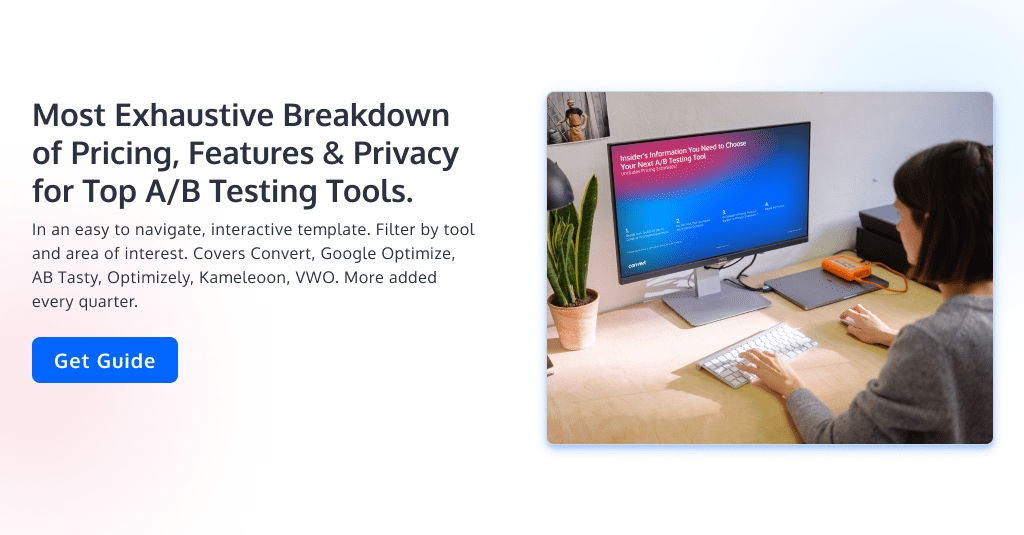
Written By
Alex Birkett
Edited By
Carmen Apostu



